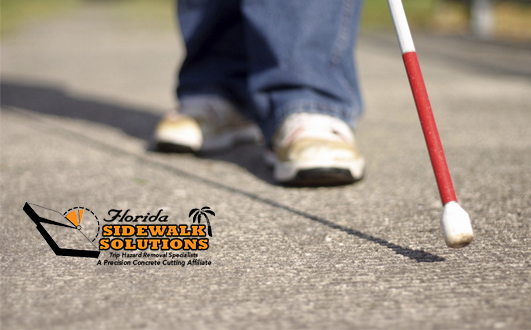Compliant Walkways are Important! by FSS
Compliant walkways and sidewalks are required in order to avoid fines and/or worse- being responsible for serious injury to yourself or others. According to the National Floor Saftey Institute, more than 8 million hospital visits a year account from fall downs, 1 million of those are from slip and falls. Fractures, which are a serious consequence of these fall downs, account for approximately 5% of the total accidents. Payouts in these incidents to cover physical, financial, and emotional loss range anywhere from 15 thousand to 45 thousand dollars on average. Because of these kinds of incidence the ADA, or Americans with Disabilities Act, was formed in the 90’s decade in order to create laws, like those pertaining to Sidewalk Compliance, to keep the owners and managers of their respective properties responsible for maintaining the physical integrity of the walkways in order to remain safe for those who have a handicap in the traversal of these areas.
When you’re sidewalk or walkway, is damaged in such a way that there is a significant gap between the height of one portion of the sidewalk or another, this creates what the ADA refers to as a ‘ Trip Hazard’. A trip hazard is dangerous and can result in serious personal injury. It is the responsibility of the owners and property managers to inspect the location for such hazards. In order for your location to retain proper walkway or sidewalk compliance, the following criteria must be met:
- Width:
In order to properly accommodate mobility equipment such as wheelchairs, a sidewalk has to be a minimum width of 3 feet – or 36 inches. It can be larger, and in fact, if it is less than 5 feet – or 60 inches- wide it will require additional passing spaces at least every 200 feet to allow pedestrians to safely move around each other.
Sidewalk width requirements are especially important for wheelchair-bound individuals. For ADA compliance, the minimum sidewalk width is 36 inches (3 feet), though sidewalks can be wider. - Texture:
Sidewalk texture needs to be pro-friction and slip-resistant. There can be no cracks or uneven areas, which leads us to the next item. - No Trip Hazards
A sidewalk or walkway cannot have a sudden height differential of 1/4″ or more. Over time, the land underneath the sidewalks becomes uneven as well as other factors like damages, erosion, weather, etc. If this height difference exists, it has to be taken care of with a repair before an issue occurs resulting in injury and liability on part of the property owner. - Slope:
A sidewalk Cannot Have a slope ratio of greater than 1:20 at any point or it is considered a ramp- which has its own set of rules. - Curbs:
Curb Ramps are required to
Florida Sidewalk Solutions Provides a less expensive alternative to replacement, called sidewalk leveling. We simply cut, shave, and smoothing any uneven portion so that they fall into Sidewalk Compliance from the ADA. Call today for more info! 954-514-7218.
Related Post: ADA Compliance, What Is It?
Find us on: Facebook | LinkedIn | Yelp

